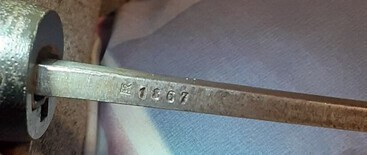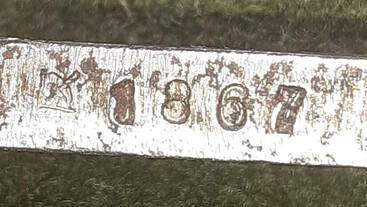-
Posts
13,197 -
Joined
-
Last visited
-
Days Won
157
Content Type
Profiles
Forums
Events
Store
Downloads
Gallery
Everything posted by Bruce Pennington
-

Copper Type 95 NCO questions
Bruce Pennington replied to elktonjohn's topic in Military Swords of Japan
That could easily go for US$2000-$2400 USD. It’s intact, and a copper handle. Many guys would like to have one of these in their collection. -

Copper Type 95 NCO questions
Bruce Pennington replied to elktonjohn's topic in Military Swords of Japan
Full length photo of the entire thing; clear photo of tsuka with stamps; good shot of blade tip and sample of blade section. -

Help with 1st Japanese sword
Bruce Pennington replied to Crayonbone's topic in Military Swords of Japan
Not the other side. They often will stamp the back edge. like this (except you’d might simply be a Gifu. -

Plimpton Swords Going to Auction
Bruce Pennington replied to mdiddy's topic in Auctions and Online Sales or Sellers
Just ordered my copy (shipping was only $8 USD). From the few times his collection and book have been discussed, it seems he's got some photos of swords in the book not found in the Dawson and Fuller books. Top notch photography too. So, I suspect it will be a valuable reference to add to the working set. As to cost, it's cheaper than either of the Dawson or Fuller books. -

Help with 1st Japanese sword
Bruce Pennington replied to Crayonbone's topic in Military Swords of Japan
Oh, yes, could you check the back edge of the nakago (tang) for a similar stamp? -

Help with 1st Japanese sword
Bruce Pennington replied to Crayonbone's topic in Military Swords of Japan
Dang! Best team-work thread I've ever seen, brings tears to my eyes! Love it. (I'd say I'm joking.....but I'm not!) Last tid-bit - the small stamp, partially struck, is the "Gifu in Sakura" stamp. We began seeing them on blades in 1943, when the "Seki" stamp ended. Seki is in the Gifu prefecture. The Seki Cutlery Manufacturers Assoc. used the Seki stamp to mark approved showato, but the Nagoya Army Arsenal absconded the stamp to use as one of their Inspector stamps in 1943. It is speculated, not known, that the Association started using the Gifu in Sakura as their stamp from that point onward. Most of the dated blades with it are in 1945, but a good many of '44 blades have them, and just a few '43 blades. -

Copper Type 95 NCO questions
Bruce Pennington replied to elktonjohn's topic in Military Swords of Japan
John, Thanks for the explanation about the scammers and your shop. It's incredible the time and effort those guys put into their work. Like the guys that fake swords, if they'd use the same skill and ingenuity to do honorable work, they'd still make a good living. It's a shame. -

Help me identify a sword smith marks
Bruce Pennington replied to enzo's topic in Military Swords of Japan
Damascus steel is a Chinese standard for these. Japanese never used it. -

Show Us Your High Class Gunto
Bruce Pennington replied to lonely panet's topic in Military Swords of Japan
Looks like 2 of them have thinner tsuba? I'm still learning differences between the 94/98, so just an educational question, John. Also, I'm not OCD or anything, but that top gunto needed to be moved more to the right, as the tsuba are alternating - left, right, left, right, etc - except for that top one! HA! sorry, just messin' with ya. Nice collection, buddy boy! -
"Kai" is my short-hand for "kaigunto" or Navy sword.
-
Thanks David! That's a new one for the files!
-
Gorgeous John!
-
Steve, Difficult to say. As a buyer, and I was looking at your kai and a "perfect" kai with the navy menugi, I personally would chose the one with the Navy menugi, regardless of price. But other collectors, who have different collecting goals, might not care if the price is right (cheaper). So, in general, I could say, yes it would lower the price, but there is such a variety of buyers and what they want and why they want it. That's why I said, earlier, that I'd set the asking price at normal market value and wait to see what offers come in.
-

Show us your nice Gendai blades
Bruce Pennington replied to IJASWORDS's topic in Military Swords of Japan
Ok, after taking a close look at the staining about the "7" and a stain off the end of the saka stamp, I believe they are the same blade, and "1867". I'll correct my charts. Boy that '8' in the older photo sure looks different. Previous Updated -

Show us your nice Gendai blades
Bruce Pennington replied to IJASWORDS's topic in Military Swords of Japan
Also, I have a " 阪1367" on file as one of yours, correct? I double-checked and they are definitely not the same blade. -

Show us your nice Gendai blades
Bruce Pennington replied to IJASWORDS's topic in Military Swords of Japan
Eric - @rancho - Nagamitsu made some gorgeous blades. Congrats on yours! Thanks for the number, too. I assume no date on the other side? -

HUGE mune inscription, and mei, Please!
Bruce Pennington replied to Bruce Pennington's topic in Translation Assistance
HUGE I'm tellin' ya!!! Ha! -
DOHHH! Trying to do too many things at once, and forgot that! Thanks Stephen!
-
-
Steve, Kaigunto prices are higher than Army because they are more rare, or less common. There's just not as many of them. Plus they are "prettier" than the plain Army gunto. Thanks for the stamp! The large seki stamp was used by the Seki Cutlery Manufacturers' Association to mark good quality blades. It is not know for a fact whether they are only on showato, but I believe that is the case, and higher quality showato at that. You can read more about this in the Stamps of the Japanese Sword document. A good close-up of a section of the blade, showing steel hada (grain) and hamon details might help guys give you a more educated opinion. I'm no nihonto guy, so my opinion on that is not worth anything.
-

HUGE mune inscription, and mei, Please!
Bruce Pennington replied to Bruce Pennington's topic in Translation Assistance
Thanks Uwe! Google searched: "Hachiman is commonly viewed as a Japanese god of war but he’s mostly worshipped as a patron kami of warriors and archery, and not of war itself. The archer kami was initially worshipped near-exclusively by warriors and samurai but his popularity eventually extended to all people in Japan and now he’s also viewed as the patron kami of agriculture and fishing as well." -

HUGE mune inscription, and mei, Please!
Bruce Pennington replied to Bruce Pennington's topic in Translation Assistance
@Okan - any chance of gettting a link to the original sale pages? -

Star stamped Ww2 traditionally forged
Bruce Pennington replied to Pippo's topic in Military Swords of Japan
Ok, that's just not nice! Now we're all going to have to wait to see what you've got! -
Also, would you mind posting a clear picture of the stamp you mentioned?
-
Yes, I love the hamon on it. Even if it's oil quenched, it's still a beauty. Ok.......thanks for bringing up the shark-skin saya. I hadn't noticed that, but was simply seeing the dull sheen of the photos from a distance. After zooming, you are right. So, forget all I've said up to this point about the possibility of it being a post-war souvenir. Nothing about it, with exception of the Army menugi is symptomatic of the Toyokawa souvenir. I've not followed current market prices on kaigunto. Pre-covid, they sold around $2,400 plus or minus. Re-wrapped tsuka are not uncommon, as many gunto came home with some really damaged ito. The only oddity, then is the menugi. I personally wouldn't downgrade a kaigunto much for that, as who knows if it was done post-war or simply late war. It's a pretty piece overall. If you're selling, I'd simply ask market price and see what counter offers come in. Sorry for getting this all confusing with my mistaken souvenir saya impression!








